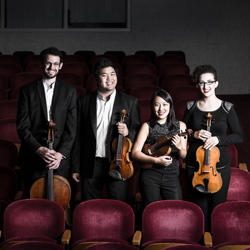by Daniel Hautzinger

Webern’s Langsamer Satz was written in 1905 while he was still a student of Schoenberg, but was only published posthumously. It is intensely expressive and closer to the Romanticism of Brahms than Webern’s own later atonality. Yet intimations of that more mature style flash through the lush harmonies, giving the impression of an unstable world on the verge of collapse.
The Wasmuth fearlessly mined the depths of that world. Second violinist Dorothy Ro’s dusky tone complimented the richness of violist Abigail Rojansky’s sound. Rojansky’s solos flitted around the songful melodies of first violinist Jonathan Ong like a shadow, while Warren Hagerty provided a steady anchor on cello.
Like the Langsamer Satz, Ligeti’s String Quartet No. 1 is an early work, written in 1953-54 in a style that the composer himself referred to as “prehistoric Ligeti.” The microtonality and sardonicism that characterize much of Ligeti’s later work are absent, but he apparently cherished the piece: when he fled Communist Hungary in 1956, he only took with him the manuscript of the quartet and a toothbrush, according to the Wasmuth.
The quartet is clearly modeled on Bartók. Chromatic motives clash against each other in dissonant imitation, invigorated by folksy rhythms and violent accents. The work’s subtitle, “Métamorphoses nocturnes,” recalls the earlier Hungarian composer’s style of “Night music,” and Ligeti even uses “Bartók pizzicatos,” where a string is snapped so that it smacks against the wood of the instrument.
Dramatic extremes collide with each other in the quartet’s single continuous movement of seventeen sections. The Wasmuth aptly conjured the kaleidoscopic textures, from sonorous chorales to demented waltzes to eerie laments. But pauses between sections were often awkwardly long, attenuating the shock of the drastic contrasts. A similar problem cropped up in the Langsamer Satz, which occasionally dies out as if it had lost the will to continue before restarting in a new vein.
Haydn’s String Quartet in C, op. 74, no. 1, presented no such pitfalls. Individual parts blended into a single organic whole in Kulas, as if the entire quartet shared a brain. Dynamic contrasts were fine-tuned to perfection, and Ong flew through solo runs with aplomb. The performance was more robust than might be expected for Haydn, though with no loss of enjoyment; instead of a sprightly, teasing fox, the Wasmuth offered a confident, brawny bear.
For their energetic encore, the Wasmuth chose a piece that they performed a year ago in Oberlin for the first Chamber Music Intensive: the fourth movement of Ravel’s String Quartet. Maybe next year they’ll bring back the Ligeti. I would be happy to hear it again.
Published on ClevelandClassical.com January 8, 2015.
Click here for a printable copy of this article



